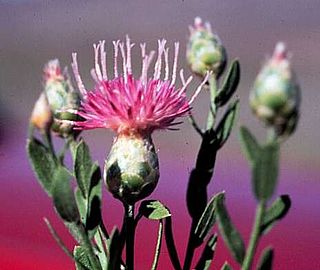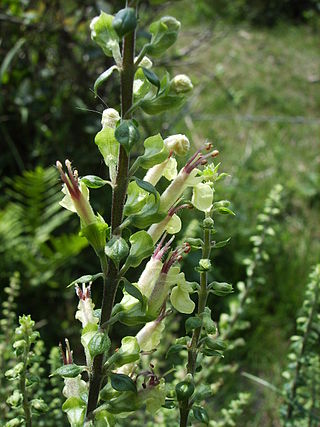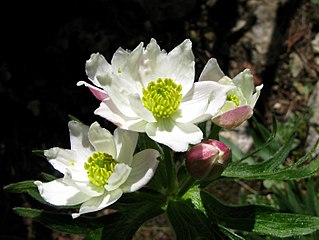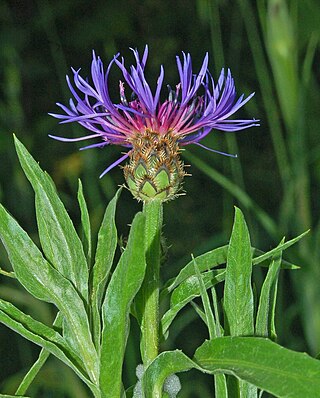
Dactylorhiza fuchsii, the common spotted orchid, is a species of flowering plant in the orchid family Orchidaceae.

Centaurea is a genus of over 700 species of herbaceous thistle-like flowering plants in the family Asteraceae. Members of the genus are found only north of the equator, mostly in the Eastern Hemisphere; the Middle East and surrounding regions are particularly species-rich.

Rhaponticum repens, synonyms including Acroptilon repens and Leuzea repens, with the common name Russian knapweed, is a species of bushy rhizomatous perennial, up to 80 cm tall. Stems and leaves are finely arachnoid-tomentose becoming glabrous and green with age. The rosette leaves are oblanceolate, pinnately lobed to entire, 2–3 cm wide by 3–8 cm long. The lower cauline leaves are smaller, pinnately lobed; the upper leaves become much reduced, sessile, serrate to entire. The heads are numerous terminating the branches. Flowers are pink to purplish, the marginal ones not enlarged. The outer and middle involucral bracts are broad, striate, smooth with broadly rounded tips; the inner bracts are narrower with hairy tips. Pappus present with bristles 6–11 mm long. Fruit is a whitish, slightly ridged achene.

Pilosella officinarum, known as mouse-ear hawkweed, is a yellow-flowered species of flowering plant in the daisy family Asteraceae, native to Europe and northern Asia. It produces single, lemon-coloured inflorescences. Like most hawkweed species, it is highly variable and is a member of a species complex of several dozens of subspecies and hundreds of varieties and forms. It is an allelopathic plant.

Centaurea montana, the perennial cornflower, mountain cornflower, bachelor's button, montane knapweed or mountain bluet, is a species of flowering plant in the family Asteraceae, endemic to Europe. It is widespread and common in the more southerly mountain ranges of Europe, but is rarer in the north. It escapes from gardens readily, and has thereby become established in the British Isles, Scandinavia and North America. This plant has become an invasive species in British Columbia, Canada. Centaurea montana grows in meadows and open woodland in the upper montane and sub-alpine zones, in basic areas. It grows to 30–70 centimetres (12–28 in) tall, and flowers mainly from May to August.

Centaurea cineraria, the velvet centaurea, also known as dusty miller and silver dust, is a species of flowering plant in the family Asteraceae endemic to southern Italy. In natural settings, it grows on coastal cliffs, ranging from 0–350 m above sea level, hence the plant's Italian name, fiordaliso delle scogliere. Mature plants may reach 80 centimetres (31.5 in) in height. The species produces purple flowers.

Teucrium scorodonia, common name the woodland germander or wood sage, is a species of flowering plant in the genus Teucrium of the family Lamiaceae. It is native to Western Europe and Tunisia, but cultivated in many places as an ornamental plant in gardens, and naturalized in several regions.

The Cardueae are a tribe of flowering plants in the daisy family (Asteraceae) and the subfamily Carduoideae. Most of them are commonly known as thistles; four of the best known genera are Carduus, Cynara, Cirsium, and Onopordum.

Rhaponticum is a genus of flowering plants in the tribe Cardueae within the family Asteraceae. As of November 2023, it is accepted by Plants of the World Online, but rejected by the Global Compositae Database in favour of Leuzea.

Anemonastrum narcissiflorum, the narcissus anemone or narcissus-flowered anemone, is a herbaceous perennial in the genus Anemonastrum and the buttercup family. Basionym: Anemone narcissiflora Hook. & Arn.

Centaurea triumfettii, the squarrose knapweed, is a species of plant belonging to the genus Centaurea of the family Asteraceae.

Centaurea uniflora, the singleflower knapweed, is a perennial herbaceous plant belonging to the genus Centaurea of the family Asteraceae.

Lithospermum purpurocaeruleum is a synonym for Aegonychon purpurocaeruleum (L.) Holub, also known as the purple gromwell, This plant is a herbaceous perennial rhizomatous flowering plant and it belongs to the family Boraginaceae.

Rhaponticum heleniifolium, synonym Leuzea heleniifolium, is a species of flowering plant in the family Asteraceae.

Rheum rhaponticum, the false rhubarb, rhapontic rhubarb or rhapontic, is a plant species in the genus Rheum found in the wild. It is the only Rheum species found only in Europe, and is now restricted to the Rila mountain range in south-western Bulgaria. It was introduced to other countries in Europe. It is considered to be one of the parents of the modern culinary rhubarb.

Adenostyles alliariae is herbaceous perennial flowering plant in the daisy family Asteraceae.

Iris spuria subsp. maritima is a species of the genus Iris, part of a subgenus series known as Iris subg. Limniris and in the series Iris ser. Spuriae. It is a subspecies of Iris spuria, a beardless, rhizomatous perennial plant, from coastal regions Europe and north Africa with deep blue-violet flowers.
Festuca drymeja is a species of grass in the family Poaceae. This species is native to Albania, Algeria, Austria, Bulgaria, Czechoslovakia, Greece, Hungary, Iran, Italy, Morocco, North Caucasus, Poland, Romania, Sicilia, Transcaucasus, Tunisia, Turkey, Turkey-in-Europe, Ukraine, and Yugoslavia. Its perennial and prefers temperate biomes. Festuca drymeja was first described in 1823.
Festuca indigesta is a species of grass in the family Poaceae. It is native to Algeria, Corse, France, Ireland, Italy, Morocco, Portugal, and Spain. It is perennial and mainly grows in temperate biomes. It was first described as a species by Pierre Edmond Boissier, and now is published in 1838 as Festuca indigesta.




















